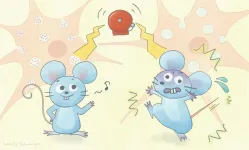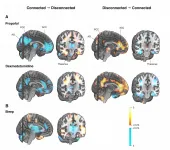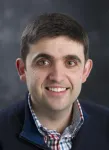(Press-News.org) Below please find a summary and link(s) of new coronavirus-related content published today in Annals of Internal Medicine. The summary below is not intended to substitute for the full article as a source of information. A collection of coronavirus-related content is free to the public at http://go.annals.org/coronavirus.
1. Review concludes universal mask use by lay persons reduces the spread of viral infections including SARS-CoV-2
Findings affirm policy promised by President-Elect Biden, who will ask Americans on Inauguration Day to wear masks for 100 days
A new narrative review of over 100 research articles concludes that masks and face coverings worn by members of the public reduce the spread of respiratory viral infections including SARS-CoV-2, the virus that causes Covid-19. The virus travels in the air in tiny droplets and particles, which are blocked to some extent even by 'imperfect' cloth face coverings. Wearing a face covering in a crowded indoor space reduces the chance that an infected person will pass the virus on to others. Even small reductions in the transmission rate can lead to large reductions in the number of people becoming infected over time.
Read the full text: https://www.acpjournals.org/doi/10.7326/M20-6625.
According to the authors from the University of Oxford, Institute for Advanced Studies, Vienna, Austria, and London School of Economics there is no evidence that masks and face coverings cause serious harm, though they can cause discomfort. There is also no evidence that wearing a mask leads to people stopping other protective behaviors, such as hand-washing. Resistance to mask-wearing is influenced by cultural norms and expectations; in some but not all cultures, the mask symbolizes the loss of autonomy and a threat to individual freedom. In such circumstances, mandated masking should be introduced only if the virus is spreading and cannot be controlled by other means.
The authors say this review is published at a critical time in the pandemic, as over 80 million people are known to have been infected with the virus and at least 1.75 million have so far died. Currently, over half a million people are becoming infected every day. While masks aren't a perfect barrier to the virus, the data strongly support wide-spread mask mandates, as observational studies suggest universal masking reduces transmission.
Media contacts: A PDF for this article is not yet available. Please click the link to read the full text. The lead corresponding author, Thomas Czypionka can be reached at czypionk@ihs.ac.at.
2. Update to 'living review' summarizes latest evidence on mask use among laypersons and health care workers
Researchers from Oregon Health & Sciences University published a fourth update to their living rapid review of evidence evaluating the use of masks among lay persons in the community and health care workers for preventing the spread of respiratory virus infections, including SARS-CoV-2, the virus that causes COVID-19. The update includes 739 citations that were published from early October to early December 2020 using the same search strategies as the original review. One study on the use of masks and the prevention of SARS-CoV-2 infection in a community setting (the DANMASK trial) and two studies in health care settings were added for the update.
Read the full text: https://www.acpjournals.org/doi/10.7326/L20-1429.
The DANMASK trial, a good-quality, open-label trial of 6,024 community-dwelling adults in Denmark evaluated the effects of wearing a surgical mask outside of the house, at a time when mask wearing in the community was neither recommended nor common. The trial found that the incidence of SARS-CoV-2 infection among participants was 2.0%. Mask use versus no mask use was associated with a small, non-statistically significant reduction in risk for SARS-CoV-2 infection. The trial was not designed to assess the effects of mask use as source control; in addition, high adherence to other infection control measures (for example, physical distancing and handwashing) could have attenuated potential benefits.
The evidence on mask use in health care settings and risk for SARS-CoV-2 infection was previously assessed as insufficient on the basis of three studies with methodological limitations. Two new cohort studies, both done in the United States, reported on mask use in health care settings. One study of 16,397 health care workers and first responders (86% health care workers) found that use of an N95 or surgical mask all of the time versus not all of the time was associated with a decreased risk for infection. In the second study, done in 20,614 asymptomatic health care workers, risk for infection was reduced with any mask use versus no mask use. An N95 mask was associated with decreased risk versus a surgical mask. However, both studies had methodological limitations, so evidence for various comparisons about mask use in health care settings and risk for SARS-CoV-2 remains insufficient.
Media contacts: A PDF for this article is not yet available. Please click the link to read the full text. The lead corresponding author, Roger Chou, MD, can be reached through the Oregon Health & Sciences newsroom at news@ohsu.edu.
INFORMATION:
What The Study Did: This study identified racial/ ethnic, sex, age, language, and socioeconomic differences in accessing telemedicine for primary care and specialty ambulatory care; if not addressed, these differences may compound existing inequities in care among vulnerable populations.
Authors: Srinath Adusumalli, M.D., M.Sc., of the Hospital of the University of Pennsylvania in Philadelphia, is the corresponding author.
To access the embargoed study: Visit our For The Media website ...
What The Study Did: Severe COVID-19 is characterized by the intense formation of neutrophil extracellular traps (NETs), leading to the blockage of microvessels, as shown in pulmonary samples. The occurrence of ST-elevated myocardial infarction (STEMI) is a serious cardiac manifestation of COVID-19; the intrinsic mechanism of coronary thrombosis appears to still be unknown. This case series report of five patients sought to determine the role of NETs in coronary thrombosis in patients with COVID-19.
Authors: Ana Blasco, M.D., Ph.D., of the Hospital Universitario Puerta de Hierro-Majadahonda in Madrid, Spain, is the corresponding ...
In 1986, cellular biochemist Kazumitsu Ueda, currently at Kyoto University's Institute for Integrated Cell-Material Sciences (iCeMS), discovered that a protein called ABCB1 could transport multiple chemotherapeutics out of some cancer cells, making them resistant to treatment. How it did this has remained a mystery for the past 35 years. Now, his team has published a review in the journal FEBS Letters, summarizing what they have learned following years of research on this and other ATP-binding cassette (ABC) transporter proteins.
ABC transporter proteins are very similar across species and have various ...
Scientists have suspected mutations in a cellular cholesterol transport protein are associated with psychiatric disorders, but have found it difficult to prove this and to pinpoint how it happens. Now, Kazumitsu Ueda of Kyoto University's Institute for Integrated Cell-Material Sciences (iCeMS) and colleagues in Japan have provided evidence that mice with disrupted ABCA13 protein demonstrate a hallmark behaviour of schizophrenia. The team investigated ABCA13's functions and published their findings in the Journal of Biological Chemistry.
ABCA13 belongs to a family of cellular transporter proteins called ATP-binding ...
Philadelphia, December 29, 2020 - Posttraumatic stress disorder (PTSD) is a complex psychiatric disorder brought on by physical and/or psychological trauma. How its symptoms, including anxiety, depression and cognitive disturbances arise remains incompletely understood and unpredictable. Treatments and outcomes could potentially be improved if doctors could better predict who would develop PTSD. Now, researchers using magnetic resonance imaging (MRI) have found potential brain biomarkers of PTSD in people with traumatic brain injury (TBI).
The study appears in ...
What happens in the brain when our conscious awareness fades during general anesthesia and normal sleep? Finnish scientists studied this question with novel experimental designs and functional brain imaging. They succeeded in separating the specific changes related to consciousness from the more widespread overall effects, and discovered that the effects of anesthesia and sleep on brain activity were surprisingly similar. These novel findings point to a common central core brain network fundamental for human consciousness.
Explaining the biological basis of human ...
A fascinating substance with unique properties, ice has intrigued humans since time immemorial. Unlike most other materials, ice at very low temperature is not as ordered as it could be. A collaboration between the Scuola Internazionale Superiore di Studi Avanzati (SISSA), the Abdus Salam International Centre for Theoretical Physics (ICTP), the Institute of Physics Rosario (IFIR-UNR), with the support of the Istituto Officina dei Materiali of the Italian National Research Council (CNR-IOM), made new theoretical inroads on the reasons why this happens and on the way in which some of the missing order can be recovered. In that ordered state the team ...
Small studies have suggested that a group of medications called RAS inhibitors may be harmful in persons with advanced chronic kidney disease, and physicians therefore often stop the treatment in such patients. Researchers at Karolinska Institutet now show that although stopping the treatment is linked to a lower risk of requiring dialysis, it is also linked to a higher risk of cardiovascular events and death. The results are published in The Journal of the American Society of Nephrology.
Chronic kidney disease (CKD) affects approximately ten percent of the global population. Hypertension is ...
Scientific articles in the field of physics are mostly very short and deal with a very restricted topic. A remarkable exception to this is an article published recently by physicists from the Universities of Münster and Düsseldorf. The article is 127 pages long, cites a total of 1075 sources and deals with a wide range of branches of physics - from biophysics to quantum mechanics.
The article is a so-called review article and was written by physicists Michael te Vrugt and Prof. Raphael Wittkowski from the Institute of Theoretical Physics and the Center for Soft Nanoscience at the University of Münster, together with ...
Although plants are anchored to the ground, they spend most of their lifetime swinging in the wind. Like animals, plants have 'molecular switches' on the surface of their cells that transduce a mechanical signal into an electrical one in milliseconds. In animals, sound vibrations activate 'molecular switches' located in the ear. Scientists from the CNRS, INRAE, Ecole Polytechnique, Université Paris-Saclay and Université Clermont-Auvergne (1) have found that in plants, rapid oscillations of stems and leaves ...



